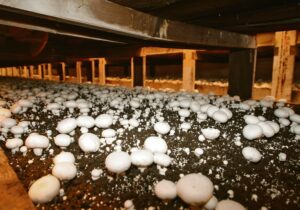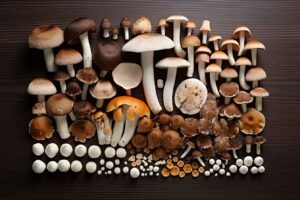Expert Tips on Setting Up the Perfect Environment for Growing Magic Mushrooms
- January 23, 2024
- 11:58 pm

Notable Elements
Controlled Environment Is Key: Successful magic mushroom cultivation hinges on managing temperature, humidity, light, and cleanliness in a controlled setting.
Space Selection Matters: Choose between indoor and outdoor cultivation based on control needs and environmental factors, with indoor spaces offering more control over growing conditions.
Temperature and Humidity Regulation: Ideal growing conditions require maintaining temperatures around 70-75°F and high humidity levels between 80-95%, crucial for healthy mycelium growth.
Lighting and Air Circulation: While not reliant on light for photosynthesis, magic mushrooms need specific light conditions for fruiting, coupled with good air circulation to promote healthy growth and prevent CO2 buildup.
Sterile Techniques and Substrates: Sterilization of equipment and substrates is vital to prevent contamination; choose nutrient-rich substrates appropriate for the mushroom strain.
Monitoring and Adjustments: Continuous monitoring and adjustments in the growing environment are necessary for addressing any issues promptly.
Advanced Techniques for Enhanced Yield: Employ advanced techniques like casing layer application and experimenting with different strains to improve yield and potency.
Avoiding Common Pitfalls: Be vigilant against contamination, improper moisture levels, and inadequate ventilation – common issues in mushroom cultivation.
Harvesting and Post-Harvest Process: Harvest mushrooms at the right time for maximum potency and properly dry them for storage.
Legal and Ethical Compliance: Always stay informed about local laws and cultural considerations surrounding the cultivation and use of magic mushrooms.
Introduction
Magic mushrooms, also known as psilocybin mushrooms, have garnered significant interest due to their unique properties and potential therapeutic benefits. Growing them at home can be a fascinating endeavor, but it requires precise environmental conditions to ensure successful cultivation. This article provides expert tips on setting up the perfect environment for growing magic mushrooms, covering key aspects from choosing the right space to maintaining optimal conditions throughout the growth cycle.
Understanding the Basics of Magic Mushroom Cultivation
Before diving into the specifics, it’s crucial to understand what magic mushrooms need to thrive. These fungi require a controlled environment where temperature, humidity, light, and cleanliness are carefully managed. Unlike plants, mushrooms get their nutrition from decomposing organic material and don’t require sunlight for photosynthesis. However, they do need certain light conditions for their growth cycle.
Choosing the Right Space for Cultivation
Indoor vs. Outdoor Cultivation
The first decision is whether to grow the mushrooms indoors or outdoors. Indoor cultivation offers more control over environmental conditions, which is crucial for sensitive magic mushroom species. An unused closet, spare room, or a grow tent can serve as an ideal space for indoor cultivation. Outdoor cultivation, while less controllable, can be successful in temperate climates but requires careful site selection and preparation.

Ensuring Sterility and Cleanliness
Regardless of the location, the space must be meticulously clean. Fungi are susceptible to contaminants, including molds and bacteria. Sterilizing the area and equipment before starting and maintaining cleanliness throughout the process is vital to prevent contamination.
Optimizing Temperature and Humidity
Temperature Requirements
Magic mushrooms generally thrive in mild temperatures, typically between 70-75°F (21-24°C). It’s crucial to maintain this temperature range consistently. Fluctuations can stress the mycelium (the vegetative part of the fungus) and hinder growth.
Humidity Control
Humidity is another critical factor. Magic mushrooms need high humidity levels, usually between 80-95%. This can be achieved by using a humidifier or by misting the growing area regularly. However, avoid over-saturation, as excess moisture can lead to mold growth.
Managing Light and Darkness
While magic mushrooms don’t rely on light for photosynthesis, they do require a certain light cycle to trigger fruiting. Indirect natural light or a few hours of fluorescent artificial light per day is sufficient. Total darkness is not recommended, as some light is necessary for the mushrooms to develop properly.
Air Circulation and CO2 Levels
Good air circulation is essential for healthy mushroom growth. It helps in maintaining humidity and temperature, and also in reducing the buildup of carbon dioxide produced by the mycelium. Stagnant air and high CO2 levels can lead to poorly developed mushrooms. Using an air pump or periodically fanning the growing area can ensure adequate air exchange.
Substrate and Inoculation Techniques
Choosing the Right Substrate
The substrate is the growing medium for mushrooms. It needs to be nutrient-rich and suitable for the specific mushroom strain being cultivated. Common substrates include rye grain, brown rice flour, and vermiculite. The substrate should be sterilized before inoculation to prevent contamination.
Inoculation and Colonization
Inoculation involves introducing mushroom spores or mycelium into the substrate. This is usually done in a sterile environment to avoid contamination. Once inoculated, the substrate needs to be kept in a dark, warm place to allow for colonization, which can take several weeks.
Monitoring and Adjusting Growth Conditions
Constant monitoring and adjustment of environmental conditions are crucial for the successful cultivation of magic mushrooms. Regular checks for contamination, adjustments in humidity and temperature, and ensuring proper light and air circulation are all part of the process. It’s also important to handle the mushrooms delicately during their growth and harvesting phases.
Advanced Cultivation Techniques
Once you have mastered the basics of magic mushroom cultivation, you might consider exploring advanced techniques to enhance yield and potency.
Casing Layer Application
A casing layer, typically a mix of peat moss and lime, can be applied to the colonized substrate. This layer helps in retaining moisture and can trigger a more robust fruiting phase. It also protects the mycelium from drying out and can lead to a more even mushroom growth.
Experimenting with Strains
Different strains of magic mushrooms have varying growth patterns and potency levels. After gaining experience with standard strains, you might experiment with other types, each offering a unique cultivation challenge and experience. Be sure to research the specific needs of each strain, as some may require different temperatures, humidity levels, or substrates.

Common Pitfalls in Mushroom Cultivation
Even with the best preparations, cultivators can encounter issues. Here are some common pitfalls and how to avoid them:
Contamination
The biggest threat to your mushroom crop is contamination. It can come from unsterilized equipment, poor air quality, or an unclean environment. To prevent this, always sterilize your equipment and substrates, maintain a clean growing area, and reduce direct contact with the substrate and mushrooms as much as possible.
Improper Moisture Levels
Both excessive moisture and dry conditions are harmful. Too much moisture can lead to mold and bacterial growth, while too little can dry out the mycelium and halt growth. Regularly check the moisture level of your substrate and adjust your watering practices accordingly.
Inadequate Ventilation
Lack of proper ventilation can lead to a buildup of carbon dioxide, which can cause stunted or abnormal growth. Ensure that your growing space has enough air exchange to maintain a healthy environment for your mushrooms.
Harvesting and Post-Harvest Handling
Knowing when and how to harvest your mushrooms is as crucial as the cultivation process itself.
Identifying the Harvesting Time
The perfect time to harvest magic mushrooms is just before the veil under the mushroom cap breaks. At this point, the mushrooms have reached their peak potency. Harvesting at the right time ensures maximum potency and prevents the spores from making a mess.
Post-Harvest Processing
After harvesting, drying the mushrooms is vital for long-term storage. A food dehydrator set at a low temperature is ideal for this purpose. Properly dried mushrooms can be stored in an airtight container in a cool, dark place for several months.
Also Read : Why Has Growing Magic Mushrooms At Home Suddenly Started To Boom?
Legal and Ethical Considerations
Lastly, it’s important to consider the legal and ethical aspects of growing magic mushrooms. The legality of cultivating psilocybin mushrooms varies from region to region. It’s essential to stay informed about the laws in your area to avoid legal repercussions. Additionally, understanding and respecting the cultural significance of these fungi in various traditions is crucial for responsible use.
Conclusion
Growing magic mushrooms can be a deeply rewarding hobby that combines the art of cultivation with the science of mycology. By creating the perfect environment and being mindful of advanced techniques and potential pitfalls, cultivators can enjoy the unique process of growing these fascinating fungi. Remember, the key to successful cultivation lies in patience, attention to detail, and a continuous willingness to learn and adapt. As always, prioritize legality and safety in all aspects of cultivation and use.

Hi! I’m Jacob Hawthorne, a passionate medical student dedicated to exploring the fascinating world of psychedelics, particularly magic mushrooms (commonly known as shrooms). With a deep interest in their therapeutic potential and profound effects on the human mind, I aim to provide accurate and evidence-based information about shrooms in the Canadian context.
